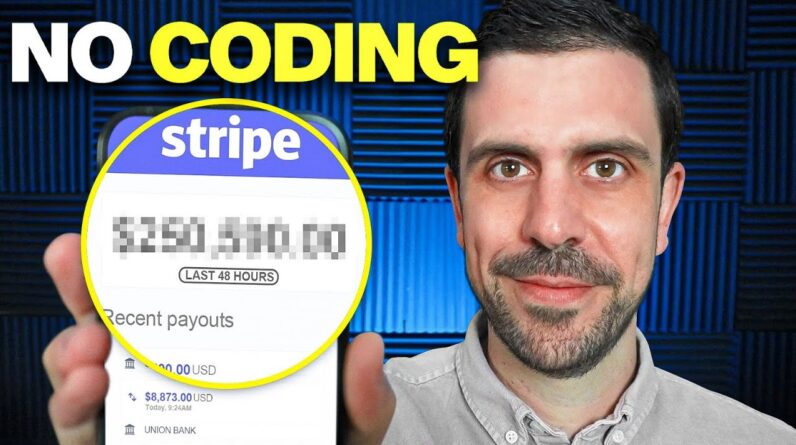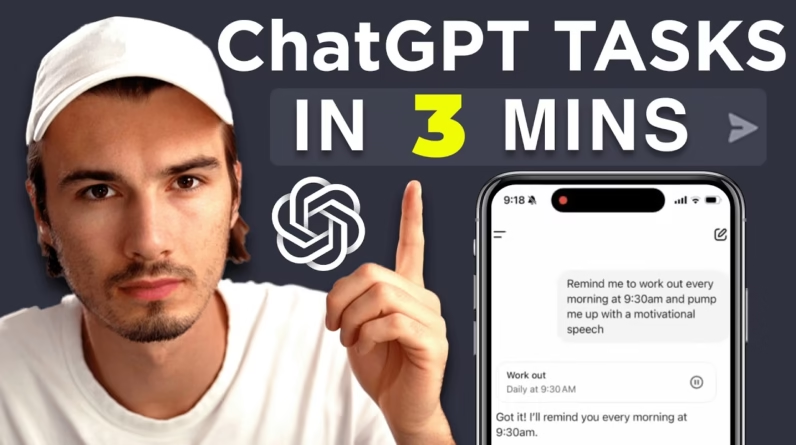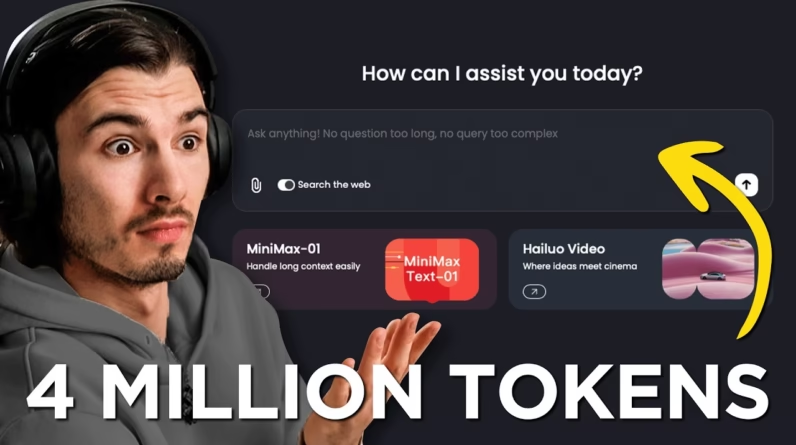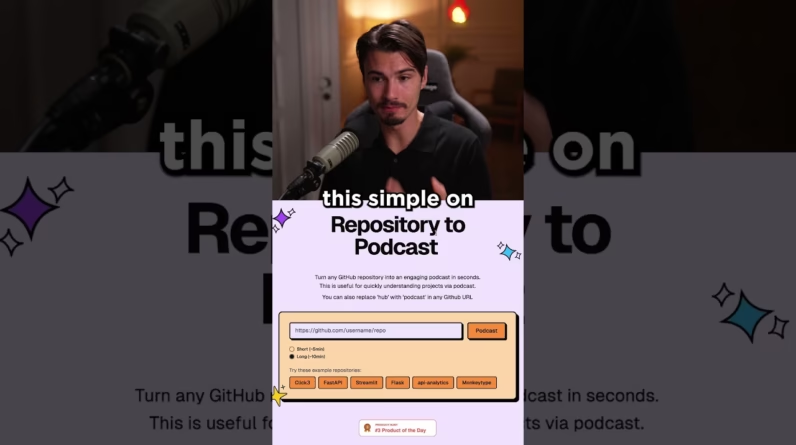
In the journey of entrepreneurship, the idea of creating an AI-driven app without the need for coding might seem daunting, but it’s entirely possible. This article outlines how Christian Peverelli from WeAreNoCode quickly developed a practical solution for podcasters who struggle with time-consuming research. By leveraging innovative tools and collaborative brainstorming with his co-founder, Cole, he successfully launched a research assistant app tailored to streamline the preparation process for podcast interviews—all within just 48 hours.
You’ll discover how Christian navigated the essential steps from idea generation and market validation to branding and product development. Key insights include the importance of understanding your audience, utilizing available resources creatively, and ensuring ease of use in your app. Whether you’re an aspiring entrepreneur or someone curious about AI applications, there’s plenty to learn from this rapid, no-code approach to building a business.
Table of Contents
Building a Profitable AI App in 48 Hours: A Journey to Create ‘Outerview’

Video Overview
Introduction to the video and its purpose
In this engaging video, Christian Peverelli from WeAreNoCode embarks on a 48-hour challenge to conceptualize, build, and launch a profitable AI app without writing a single line of code. The goal is not only to illustrate the capabilities of no-code tools in app development but also to create a functional AI-powered research assistant specifically designed for podcasters. This project serves as a roadmap, providing valuable insights for both aspiring entrepreneurs and seasoned developers.
Discussion of Christian Peverelli’s expertise
Christian Peverelli is a seasoned entrepreneur with a wealth of experience in launching successful startups. He specializes in leveraging no-code tools to streamline app development and ensure rapid deployment. With a background in business and technology, Christian has a knack for identifying market needs and crafting solutions that resonate with potential users. His expertise lies in simplifying complex processes, making it accessible and achievable for everyone, regardless of their technical skill level.
Key objectives of the video overview
The key objectives of the video are to showcase the efficiency of no-code development tools, demonstrate the feasibility of launching a business in a short time frame, and highlight the potential benefits of using AI in streamlining time-intensive tasks for podcasters. By the end of the video, viewers should feel inspired and empowered to pursue their own entrepreneurial ventures, armed with practical examples and strategies.
Goal of the Project
Development of an AI-powered research assistant
The central focus of the project is to develop an AI-powered research assistant tailored for podcasters. This assistant aims to alleviate the often tedious and time-consuming research process associated with preparing for interviews by automating information gathering and generating insightful questions. By doing so, it allows podcasters to concentrate more on their discussions and less on background research.
Target market: Podcasters
The identified target market includes podcasters, especially those with small followings who may lack dedicated research teams or extensive resources. This demographic typically faces challenges in managing their time effectively, making an automated research assistant especially appealing as it could streamline their workflow significantly.
Desired outcomes for users
The desired outcomes for users include increased efficiency in preparing for episodes, enhanced interview quality through more informed discussions, and ultimately, a greater ability to engage with their audience. By reducing the research burden, podcasters would allow themselves to capitalize on creative energy, providing fresh and dynamic content for their listeners.
Collaborative Efforts
Role of the co-founder Cole
Christian’s co-founder, Cole, plays a pivotal role in the project. Their collaboration brings different strengths to the table, enhancing both creativity and productivity. Cole assists in brainstorming ideas, refining the app’s features, and ensuring that the app aligns with user needs and market trends.
Benefits of collaboration
The benefits of collaboration in this project are multifaceted. By working together, Christian and Cole can leverage their collective knowledge and skills, tapping into each other’s strengths to overcome challenges more effectively. Teamwork fosters diverse perspectives, leading to richer discussions and better decision-making, which is crucial in the fast-paced environment of startup development.
Effective brainstorming techniques
Emphasizing effective brainstorming techniques is essential in the early stages of the project. Christian and Cole utilize both traditional methods—such as pen and paper—and modern tools like AI to explore potential technology trends and identify problems worth solving. This combination ensures that their ideas are both innovative and grounded in real-world needs.
Idea Generation Process
Methods used for brainstorming (pen, paper, AI tools)
During the brainstorming phase, the team employs a mix of traditional and innovative methods. Pen and paper allow for free-flowing thoughts, while AI tools like ChatGPT assist in generating ideas quickly. This approach fosters an environment where creativity thrives, enabling the duo to formulate ideas that could become valuable business propositions.
Identifying technology trends
Identifying technology trends is crucial for ensuring that the development effort aligns with market needs. Christian and Cole analyze current developments in AI and no-code platforms, seeking ways to integrate these trends into their application. Understanding what tools and technologies are gaining traction helps in shaping a relevant product offering.
Focus on the specific problem of time-consuming research
The project’s main focus is to address the specific problem of time-consuming research faced by podcasters. By honing in on this issue, they can create a solution that resonates strongly with their target audience, thereby increasing the likelihood of market acceptance and success.
Defining the Target Market
Identifying demographics of podcasters
To ensure the product fits their audience, Christian and Cole need to clearly define the demographics of podcasters. They focus on younger or emerging podcasters who have a passion for content creation but lack the resources for extensive research. Understanding who their potential users are will guide their development process.
Needs of podcasters with small followings
Podcasters with small followings often juggle multiple roles—from content creation to editing and research. Their primary needs include a tool that saves them time, helps them produce higher-quality content, and enhances their ability to engage with guests and listeners. Catering to these needs is integral to the app’s value proposition.
Market research insights
Insights gathered from quick market research validate the identified needs of podcasters. This involves reviewing online forums, social media, and podcasting communities to gauge pain points and discuss challenges faced by podcasters in their research process. Such insights serve as a foundation for building a product that truly addresses market demands.
Business Model Structuring
Free version vs. subscription model
The proposed business model includes both a free version and a subscription model for the app. The free version allows users to experience basic functionalities, while the paid subscription offers premium features such as in-depth research capabilities and advanced analytics. This tiered approach aims to attract a wide range of users while providing a pathway for monetization.
Discussing pricing strategy
The pricing strategy focuses on affordability to ensure that the app is accessible to podcasters with varying budgets. The monthly subscription rate is designed to be reasonable, reflecting the value provided by the automated research assistant. Ongoing feedback from users will help refine the pricing strategy over time.
Value proposition for paying customers
For paying customers, the value proposition includes significant time savings, improved research quality, and enhanced interview preparedness. A strong emphasis is placed on the app’s ability to simplify the research process, thus visually showcasing how the tool can streamline their operations and help them deliver better content.
Validation Process
Methods of gathering feedback without long interviews
Christian and Cole aim to gather feedback quickly due to time constraints. They decide against lengthy customer interviews, opting instead for concise surveys among fellow podcasters. This method allows them to gather meaningful insights while respecting the busy schedules of podcasters.
Conducting quick surveys among podcasters
The quick surveys focus on understanding the most significant pain points that podcasters face during their research process. By asking targeted questions, they can assess the demand for the AI-powered research assistant, enabling them to pivot or adjust features based on real user feedback.
Online research for market demand confirmation
To complement their surveys, Christian and Cole conduct online research looking for discussions on forums and social media platforms regarding the challenges of podcast guest research. This research helps confirm the demand for a tool that can alleviate these challenges, solidifying their confidence in moving forward with development.
Brand Development Journey
Exploration of brand names and domains
Branding is a crucial aspect of establishing the app’s identity. Christian and Cole explore numerous brand names and domain options before settling on “Outerview,” inspired by the way podcasters often seek research help. This name encapsulates their service’s essence, aiming to add depth to the user’s interviews.
Logo creation process using Fiverr AI
To create a professional image for their brand, they utilize Fiverr’s AI logo generator, which provides a quick and efficient way to develop visuals. The result is a tailored logo that aligns with the app’s mission—creating an immediate brand recognition that resonates with potential users.
Establishing a color palette with Coolers
With the logo in place, attention turns to establishing a cohesive color palette. They use a tool called Coolers to generate a selection of colors that will be consistent across all branding materials. A focus on a key green color enhances the brand’s identity and appeal, ensuring a polished look.
Website and Product Development
Utilizing Softer for landing page creation
Christian and Cole construct a sleek landing page using Softer, enabling them to promote their brand effectively. This no-code approach allows them to design a user-friendly interface that communicates the app’s purpose clearly, enticing potential users to learn more and sign up.
Incorporating a free trial offer
A significant component of their marketing strategy is offering a free trial, enabling users to try the app before committing to a subscription. This not only helps in building trust but also showcases the app’s functionality and benefits, thereby increasing the likelihood of converting free users into paying customers.
Building out functionalities through various tools
The team integrates various tools such as Make and Airtable to add functionalities to their app, automating crucial tasks like retrieving guest profiles and generating relevant questions for interviews. By doing so, they enhance the user’s experience, ultimately allowing podcasters to focus on core content creation.
Conclusion
Summary of key learnings from the project
Reflecting on the 48-hour project, key learnings include the importance of efficient brainstorming, understanding market needs, and developing a strong brand identity. The experience underscores the value of collaboration and flexibility in navigating challenges during a startup’s inception phase.
Encouragement for aspiring app developers
For aspiring app developers, this challenge serves as a beacon of inspiration. If you have a compelling idea and the determination to see it through, you can leverage no-code tools to bring your vision to life. Don’t be afraid to innovate, explore opportunities, and allow your creativity to guide your journey.
Future outlook for no-code AI app development
As the landscape of app development continues to evolve, the future is bright for no-code solutions, particularly in the realm of AI applications. With increasing accessibility and utility, no-code tools will empower more individuals to realize their entrepreneurial aspirations, contributing to a vibrant ecosystem of innovative startups. Embrace this journey; the possibilities are endless!







